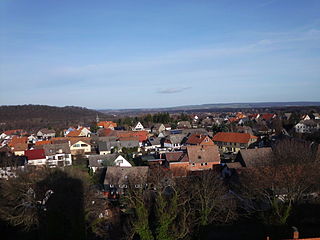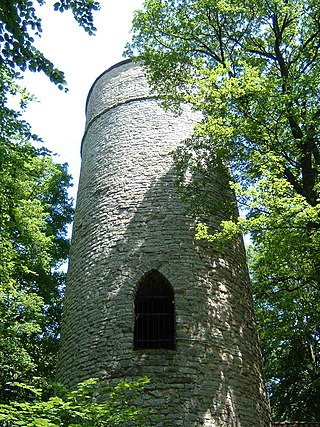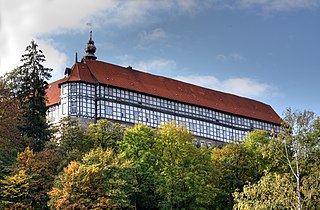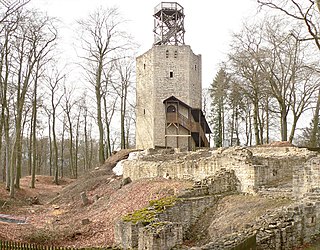History
The first castle was occupied in around 1330 by the "noble lords of Rosdorf".
In 1324, the Muthaus (Moshus = palas ) was built by Conrad and Louis of Rosdorf and the place was expanded into large castle complex. The Muthaus has a height of 35 metres and is probably the oldest, fully surviving secular building in southern Lower Saxony. The expansion appears to have overstretched the lords financially.
In 1379, Duke Otto of Brunswick and Göttingen (Otto the Evil) acquired the castle. In 1380, it was the seat of government for the Welf duke after he had been driven out of Göttingen; he died here on 13 December 1394. The castle then became the dower seat of Duchess Margareta.
In 1560, Hardegsen ceased to be the princely residence and dower seat. From 1568 to 1823 the old castle became the head office of the Amt of Hardegsen, headed by a Drost or Amtmann .
From 1725 to 1780 major remodelling work was carried out on the castle in order to turn it into domestic buildings for the future estate (Domäne). Of the old castle, only the Muthaus, the Hagenhaus and parts of the castle wall remain.
In 1972 the estate and castle site were sold to the town of Hardegsen, who then rented it out. The Muthaus may be visited today, but is also hired out for events and celebrations. It is hired by the Hardegsen Cultural Project (Kulturinitiative Hardegsen). The income is used to maintain the castle. The great hall is used in spring and summer as a registry office.

The Duchy of Brunswick and Lüneburg, commonly known as the Duchy of Brunswick-Lüneburg or Brunswick-Lüneburg, was an imperial principality of the Holy Roman Empire in the territory of present day Lower Saxony.

The Principality of Calenberg was a dynastic division of the Welf Duchy of Brunswick-Lüneburg established in 1432. Calenberg was ruled by the House of Hanover from 1635 onwards; the princes received the ninth electoral dignity of the Holy Roman Empire in 1692. Their territory became the nucleus of the Electorate of Hanover, ruled in personal union with the Kingdom of Great Britain from 1714 onwards. The principality received its name from Calenberg Castle, a residence of the Brunswick dukes.

The Principality of Göttingen was a subdivision of the Duchy of Brunswick-Lüneburg in the Holy Roman Empire, with Göttingen as its capital. It was split off from the Principality of Brunswick-Wolfenbüttel in 1286 in the course of an estate division among members of the ruling House of Welf. In 1495 the Göttingen lands were incorporated as integral part of the newly established Brunswick Principality of Calenberg, with which they stayed united until the territory was merged into the Electorate of Hanover.
The Principality of Lüneburg was a territorial division of the Duchy of Brunswick-Lüneburg within the Holy Roman Empire, immediately subordinate to the emperor. It existed from 1269 until 1705 and its territory lay within the modern-day state of Lower Saxony in Germany. The principality was named after its first capital, Lüneburg, which was ruled jointly by all Brunswick-Lüneburg lines until 1637. From 1378, the seat of the principality was in Celle. It lost its independence in 1705 when it was annexed by the Electorate of Brunswick-Lüneburg, but retained its vote in the Reichstag as Brunswick-Celle.

Vienenburg is a borough of Goslar, capital of the Goslar district, in Lower Saxony, Germany. The former independent municipality was incorporated in Goslar on 1 January 2014.

Bleckede is a town in the district of Lüneburg, in Lower Saxony, in northern Germany. It is situated mostly on the left bank of the Elbe, approx. 20 kilometres (12 mi) east of Lüneburg.

Hardegsen is a town in the district of Northeim, in Lower Saxony, Germany. It is situated approximately 15 km southwest of Northeim, and 15 km northwest of Göttingen.

Nörten-Hardenberg is a municipality in the district of Northeim, in Lower Saxony, Germany.

Göttingen is a university city in Lower Saxony, central Germany, the capital of the eponymous district. The River Leine runs through it. At the end of 2019, the population was 118,911.

Anhalt Castle is a ruined medieval fortification near the town of Harzgerode in Saxony-Anhalt, Germany.

The Principality of Brunswick-Wolfenbüttel was a subdivision of the Duchy of Brunswick-Lüneburg, whose history was characterised by numerous divisions and reunifications. It had an area of 3,828 square kilometres in the mid 17th century. Various dynastic lines of the House of Welf ruled Brunswick-Wolfenbüttel until the dissolution of the Holy Roman Empire in 1806. As a result of the Congress of Vienna, its successor state, the Duchy of Brunswick, was created in 1815.

Grubenhagen Castle is a ruined medieval castle in North Germany dating to the 13th century. It is not far from the town of Einbeck in southern Lower Saxony.

Calenberg Castle was a medieval lowland castle in central Germany, near Schulenburg in the borough of Pattensen, 13 kilometres (8.1 mi) west of the city of Hildesheim. It was built as a water castle in 1292 by the Welf duke, Otto the Strict, in der Leine river meadows between two branches of the Leine river on the southern part of the chalk marl hill of the Calenberg. At the start of the 16th century it was converted into a fort (Feste). In the 15th century, Fort Calenberg gave its name to the Welf Principality of Calenberg. Following the Thirty Years' War it lost its military importance and was slighted. Today it is a ruin with underground vaults that are surrounded by high ramparts.

Herzberg Castle is a German schloss in Herzberg am Harz in the district of Göttingen in the state of Lower Saxony. The present-day, quadrangular building has its origins in the 11th century as a medieval castle. After a fire in 1510 it was rebuilt as a schloss and is one of the few in Lower Saxony that was constructed as a timber-framed building. Because it belonged to the House of Welf for 700 years it is also known as the Welf Castle of Herzberg.

Otto the Evil was a member of the House of Guelph. He was a Duke of Brunswick-Lüneburg, from 1367 Duke in the Principality of Göttingen.
Otto II of Brunswick-Göttingen, a member of the House of Welf, was Duke of Brunswick-Lüneburg and, after the death of his father Otto the Evil in 1394, ruling Prince of Göttingen.
Lauenstein is a village in the municipality of Salzhemmendorf in the Lower Saxon district of Hameln-Pyrmont in north Germany. It has about 2,100 inhabitants.

Lichtenberg Castle, also called the Heinrichsburg, is a ruined castle dating to the 12th century in the Lichtenberge hills near Salzgitter in the German state of Lower Saxony. The ruins are found south of and above the Salzgitter suburb of Lichtenberg on the steep summit of the Burgberg.

The House of Asseburg, original German name von der Asseburg, is an old Lower Saxon aristocratic family which had its origin in Wolfenbüttel and Asseburg. During the 12th and 13th centuries the lords of Wolfenbüttel were able to establish their own small county, but were soon forced to give way to the Brunswick dukes of the House of Welf. Later their title was taken over by other families in the female line, and the counts of Asseburg continue to be landowners to this day.

A Muthaus, also Mushaus or Moshaus (~palas) is the German term for a residential, storage or refectory (dining) building connected with a castle. It is sometimes also called a Turmhaus.

















